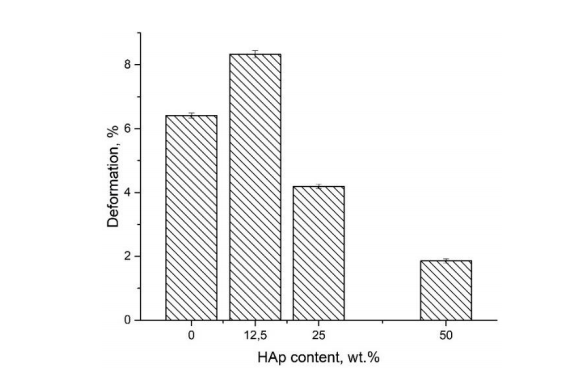Tomsk Polytechnic University Researchers Study Effects of Annealing in Bioprinting for Bone Regeneration
 Scientists from Tomsk Polytechnic University have recently published ‘Effect of annealing on mechanical and morphological properties of Poly(L-lactic acid)/Hydroxyapatite composite as material for 3D printing of bone tissue growth stimulating implants.’ Like so many other researchers today, they seek ways to refine bioprinting processes and gain one step closer to the eventual printing of human organs.
Scientists from Tomsk Polytechnic University have recently published ‘Effect of annealing on mechanical and morphological properties of Poly(L-lactic acid)/Hydroxyapatite composite as material for 3D printing of bone tissue growth stimulating implants.’ Like so many other researchers today, they seek ways to refine bioprinting processes and gain one step closer to the eventual printing of human organs.
Although annealing is a common topic regarding ways to strengthen mechanical properties in 3D printing, here the authors examine its effects on 3D-printed PLLA/HAp composite scaffolds of three compositions (12.5, 25, and 50 wt.% of HAp), using both electron microscopy and nanoindentation. Stressing the importance of metal implants to treat conditions of the musculoskeletal system, the authors point out drawbacks in more conventionally made devices such as:
- Negative impact on musculoskeletal system functioning
- High probability of rejection due to metallosis
- Surgery required to remove temporary devices
The potential for success with biodegradable implants is great, leading the researchers to biodegradable implants made of thermoplastic polymers and polymer composites. Their ability to re-absorb into the body without presenting toxins is an enormous advantage, but one that up until recently been diminished due to lack of mechanical properties and ‘uncontrolled degradation’ of the polymer matrix.
“Used in orthopedics in the form of pins and screws for fixing bone fragments [4], poly(L-lactic acid) (PLLA) has mechanical characteristics that are significantly inferior to those of natural bone,” state the researchers. “The low elastic modulus of this polymer does not ensure the preservation of the implant morphology, thereby limiting its use as a bulk osteoconductive implant.”
Previous scientific research has shown that it may be effective to fill PLLA with bioactive hydroxyapatite. Filling the material up to 50 percent by weight can increase composite stiffness twice over. In experimenting through FDM 3D printing, bending and deviation was noted in scaffolds after the annealing process. Scaffolds were cooled during the printing process, causing smaller, denser crystallites. Volumetric transformation in the crystalline structure also caused tensile stressors.
“Results of nanoindentation showed growth of Young’s modulus after annealing,” concluded the researchers. “The maximum value of 9393 ± 709 MPa Young’s modulus was reached for the annealed composite with 50 wt.% of HAp.”
Tissue engineering and bioprinting for bone regeneration are famously challenging in the 3D printing scientific realm, and researchers working diligently in laboratories around the world continue to seek new methods for better success, from refining bone ligament constructs to customizing bone graft implants to exploring methods like melt electrospinning. While there are many scientific triumphs to be met, the true reward is in changing the lives of patients, and in some cases too, saving their lives.
Find out more about the effects of annealing here. What do you think of this 3D printing news? Let us know your thoughts! Join the discussion of this and other 3D printing topics at 3DPrintBoard.com.

SEM images of 3D-printed scaffolds at 22× and 4000× magnification: (a) PLA100, (b)
PLA87.5, (c) PLA75, (d) PLA50, (e) PLA100an, (f) PLA87.5an, (g) PLA75an, (h) PLA50an.
Subscribe to Our Email Newsletter
Stay up-to-date on all the latest news from the 3D printing industry and receive information and offers from third party vendors.
You May Also Like
Gorilla Sports GE’s First 3D Printed Titanium Cast
How do you help a gorilla with a broken arm? Sounds like the start of a bad joke a zookeeper might tell, but it’s an actual dilemma recently faced by...
Nylon 3D Printed Parts Made More Functional with Coatings & Colors
Parts 3D printed from polyamide (PA, Nylon) 12 using powder bed fusion (PBF) are a mainstay in the additive manufacturing (AM) industry. While post-finishing processes have improved the porosity of...
$25M to Back Sintavia’s Largest Expansion of Metal 3D Printing Capacity Since 2019
Sintavia, the digital manufacturing company specializing in mission-critical parts for strategic sectors, announced a $25 million investment to increase its production capacity, the largest expansion to its operations since 2019....
Velo3D Initiates Public Offering in a Bid to Strengthen Financial Foundations and Drive Future Growth
Velo3D (NYSE: VLD) has been among a number of publicly traded 3D printing firms that have attempted to weather the current macroeconomic climate. After posting a challenging financial report for 2023,...

































